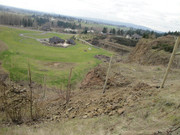bball":281jof61 said:
In the first pic, appears to be a slope. Shouldn't the post be pounded to remain perpendicular to the ground instead of true plumb? (Should be leaned more to the right hand side in pic) or does that not actually matter. What say the professionals?
Ron, the fence looks darn good.
Do you guys not use steel pipe posts there?
Post should ALWAYS be perpendicular to ground... especially on fixed knot high tensile like pictured here. Aesthetics win most of the time however.
The reason why perpendicular = the wire should never be stapled tight to post. This is what allows the fence to flex when pressured. If the stay wires are not parallel to the post, then the staples can bind on the stay wires when the fence is impacted... causing the stretch between posts to take the impact instead of the entire pull between brace assemblies.
An amazing number of fences are constructed in a fashion that only makes sense because "it has always been done this way". With the invention of fixed knot woven wire, the rules have changed. There is a method to the madness of what the companies that manufacture this are teaching. A couple of points to make you scratch your head and question traditional thinking >>>>>>>
*why do you need a strand of barbed at 55" or so when you can put a strand of electric at 36" where the animal actually pressures? How many cattle actually try to reach over the fence instead of scratching at 30-40"?
*why do people pull around curves with braces? The brace is only geometrically functional when the strain is 180 degrees to the direction of the braced rail... not in a curve. Physics (and experts) says we can pull around a 90- degree curve with single posts that are placed on 15-20 degree separations.
*why do braces appear in straight stretches when the wire is never tied off to the braces?
*why do builders still use 7' brace rails on 49" tall fabric when physics, geometry and experts recommend 10' brace rails?
*(my favorite) Why do I drive around the southeast and see fixed knot, high tensile woven wire installed on posts that are set on 10-12ft centers???? One of the benefits of such fence is to be able to spread the posts out to 25ft and have a much more flexible, effective barrier

